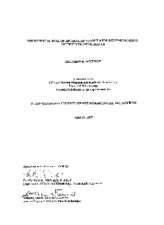| dc.creator | McCurdy, Matthew R | |
| dc.date.accessioned | 2013-02-22T20:41:59Z | |
| dc.date.available | 2013-02-22T20:41:59Z | |
| dc.date.created | 1999 | |
| dc.date.issued | 2013-02-22 | |
| dc.identifier.uri | https://hdl.handle.net/1969.1/ETD-TAMU-1999-Fellows-Thesis-M3926 | |
| dc.description | Due to the character of the original source materials and the nature of batch digitization, quality control issues may be present in this document. Please report any quality issues you encounter to digital@library.tamu.edu, referencing the URI of the item. | en |
| dc.description | Includes bibliographical references (leaves 35-41). | en |
| dc.description.abstract | Astronauts returning to earth experience hypotension from hours to days. The subsequent inability to maintain the upright (orthostatic) position diminishes work capacity. Orthostatic hypotension appears to result from weightlessness-induced cardiovascular adaptations, such as resistance vessel (arteriole) adaptations. This study investigates the effects of hindlimb unloading (simulated microgravity) on vasodilatory properties of rat skeletal muscle arterioles. Rodent hindlimb unloading is an established model of microgravity that provides the headward fluid shifts and unloading of postural muscles that occur in space. Sprague-Dawley rats were assigned to two groups: control rats (C, n =8) and hindlimb unloaded (HU, n =5). HU rats were tail suspended for 2 weeks. First order (1A) arterioles were dissected from both control and hindiimb unloaded rats and cannulated on micro-pippettes under constant pressure (60 cm H20). Vasodilatory response curves were produced by the cumulative addition of acetylcholine, adenosine, isoproterenal and sodium nitroprusside. Results indicate that hindlimb unloaded soleus muscle arterioles exhibited a decrease in acetylcholine induced dilation and gastrocnemius muscle arterioles produced diminished isoproterenol-induced dilation. Thus, dilatory properties of resistance vessels are not altered by simulated microgravity in a way that contributes to orthostatic hypotension. Since soleus muscle blood flow is known to decrease by an order of magnitude during hindlimb unloading, the shear stress against the vessel wall is reduced. Acetylcholine induces dilation through a mechanism that is similar to shear stress-induced dilation. Thus, the diminished dilation in the soleus muscle arterioles provides further evidence for elucidating a possible mechanism for the diminished aerobic capacity experienced after simulated and genuine weightlessness. | en |
| dc.format.medium | electronic | en |
| dc.format.mimetype | application/pdf | |
| dc.language.iso | en_US | |
| dc.publisher | Texas A&M University | |
| dc.rights | This thesis was part of a retrospective digitization project authorized by the Texas A&M University Libraries in 2008. Copyright remains vested with the author(s). It is the user's responsibility to secure permission from the copyright holder(s) for re-use of the work beyond the provision of Fair Use. | en |
| dc.subject | health and kinesiology. | en |
| dc.subject | Major health and kinesiology. | en |
| dc.title | The potential role of arteriolar vasodilator responsiveness in orthostatic intolerance | en |
| thesis.degree.department | health and kinesiology | en |
| thesis.degree.discipline | health and kinesiology | en |
| thesis.degree.name | Fellows Thesis | en |
| thesis.degree.level | Undergraduate | en |
| dc.type.genre | thesis | en |
| dc.type.material | text | en |
| dc.format.digitalOrigin | reformatted digital | en |


